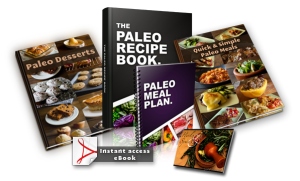In the last few years we have all become increasingly aware of the need to live and eat much healthier than we have in the past. There has been a veritable explosion of books dealing with healthy cooking recipes; one that’s really hitting the “underground news scene” in the healthy eating world is the Paleo Recipe Book. So what’s it all about, does it really work or is it just another here today, gone tomorrow fad – quickly replaced by the next big thing?
I don’t know about you but before I try something I’d like to first find out a little bit more information. So let’s have a closer look at what the “Paleo Recipe Book”actually is. The first surprising thing (and this is what got me intrigued about the whole subject) is that there is actually nothing new about this; in fact this diet is about as old as it is possible to get! The word “Paleo” is short for Paleolothic, which is an archaeological time period.
The origins of the Paleo Diet
The Paleolithic Era started about 2.5 million years ago and ended around 12,000 years ago with the introduction of agriculture. Paleolithic “man” (‘homo habilis’ would be the more correct term) was a hunter-gatherer, living together in small groups subsisting from plants and hunting wild animals. Their diet consisted of fruit, berries, nuts, roots, vegetables, meat, shellfish and fish. With the introduction of the Neolithic Era came agriculture and animal husbandry, ushering in an end to the Paleolithic Diet.
Until today that is. In fact with the recipes in the Paleo Cook Book based on the diet of 2.5 million years ago you could call it the ultimate retro diet!
So was the diet of our very ancient ‘ancestors’ that much healthier?
Well, let’s examine the facts. Paleolithic Man was lean, healthy and strong – thanks to his diet. He ate the foods that were the easiest and quickest to hunt or gather at whatever location he was temporarily at, then moved on. His was a nomadic existence, after all it is usually only permanent settlers that cultivate the land and keep animals. So he had no grains, dairy products, potatoes, salt, sugar etc in his diet. The only oils he consumed were from fruits or tree nuts; obviously no processed oils existed in those days.
OK, what’s the basic concept of Paleo Cook Book?
Well, the essential thing to remember is that the whole diet is based on high protein and low carbohydrate intake. Eating such high protein foods (eg lean meat) will aid weight loss by stimulating your body’s metabolism. There is a lot of evidence that this is one of the best way’s of losing weight; furthermore as an added bonus bear in mind that thanks to his diet Paleolithic Man was very much immune to lots of diseases and conditions that we suffer from today. Myopia, obesity, high blood pressure, cardiovascular diseases are just a few things that were completely unknown to him.
The reason being – the Paleo Diet is about as natural a diet as it is possible to follow. Full of pure, fresh natural ingredients found in meat, plants and fish (don’t forget the essential oil Omega 3) before we discovered agriculture and all that grain full of carbs.
So following such a diet makes a whole lot of sense whether you want to lose weight, whether you are suffering from a condition such as diabetes, or even if you simply want to start eating and living a whole lot healthier.
Make a start today, your body will thank you for it. Check out the tasty Paleo Recipes here for yourself.
Click here to try Paleo Recipe Book
One of the best things about a paleo diet, and by extension, paleo recipes, is that everything is gluten free – because cavemen didn’t eat grains. I am not gluten intolerant (celiac disease) myself, but I have met several people who are, and they are always looking for products, recipes, and diets that they can follow. It can be really hard for someone without a nutritional degree to know when something has gluten in it, so any resource that can cut to the chase for people with these kinds of problems can be a huge help!
The idea behind all Paleo Recipes Book is that you have never heard about fat cavemen, and cavemen didn’t eat grains. They ate fruits, fish, meats, vegetables, nuts, and roots. Grains were difficult to eat because of their hard shell – it took too much energy to make them edible for it to be worth it for the cavemen! Because of this, the diet has a very low glycemic load, making it good not only for gluten intolerance, but also for diabetics, as this type of diet is supposed to help prevent insulin insensitivity.
Personally, my favorite paleo recipe is extra simple. I call it ‘Beef and Broccoli with Au Jus’ and it goes as follows:
(Feeds Four)
Ingredients:
8 oz Ribeye x4
12 oz Beef Broth (there are several great broth recipes on the Internet, I like this one)
2 Tbls Butter
Pinch of Thyme
2 lbs Broccoli
Pour the beef broth in a sauce pan and add the 2 Tbls of butter and the pinch of thyme to the pan. Reduce over medium heat until sauce has reduced by 1/3 of its original volume. Reduce the heat on on the sauce to low and grill the ribeye steaks over medium-high heat for 5-6 minutes on each side. While grilling, steam the broccoli in a separate pot – be careful not to overcook, the broccoli should still be very green when you are done.
Once the steaks are done, dip them each in the sauce for a moment before plating. Pour the rest of the au jus over the broccoli and stir before plating the broccoli. Serve.
I hope you enjoy my recipe!
Read More at Paleo Cook Book